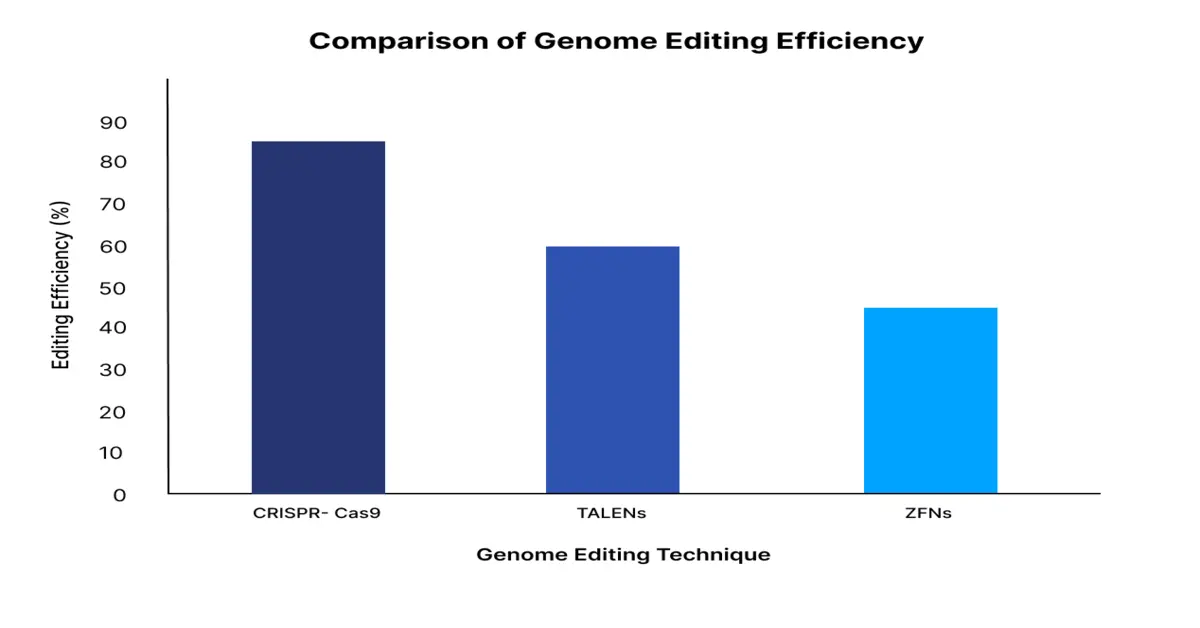Published Date : 17 September 2025
Posted by : Ipseeta Dash
Imagine a technology that could correct a typo in a book that decides the health, image, or even intelligence of an individual. That’s what genome editing does, but instead of books, it rephrases DNA, the instruction manual of life. Genome editing is a set of technologies that allow scientists to rewrite an organism’s DNA with absolute precision.
So why is everyone talking about it? As genome editing has the potential to cure chronic genetic diseases, enhance crops, remove inherited disorders, and even overcome climate change by altering genes in plants and animals. Genome editing technology is a revolutionary breakthrough that allows scientists to precisely alter DNA. Genome editing, once limited to only science fiction, is now changing medicine, agriculture, and environmental conservation in real time.
What is Genome Editing
Genome editing refers to a group of technologies that allow scientists to alter an organism’s DNA. It works like a molecular version of “cut and paste,” removing, modifying, or replacing specific parts of the genetic code. These edits can help cure faulty genes, present beneficial traits, or remove unwanted genetic material. It’s being used in everything from human gene therapy to altering plants for better crop yield.
According to Research Nester’s survey, the global genome editing market was valued at USD 9.5 billion in 2024 and is predicted to reach USD 65.0 billion by 2035, registering a CAGR of over 17.0% during the forecast period. The surge is driven by increasing investments in biotechnology, the rapid expansion of CRISPR-based research, and rising demand for personalized medicine and genetically engineered crops. Major players such as Editas Medicine, CRISPR Therapeutics, and Beam Therapeutics are emphasizing innovation, while newer biotech startups continue to enter the space with editing platforms and AI-integrated delivery systems.

Major Milestones in Genome Editing:
The idea of altering genes isn’t new, as scientists have been advancing genetic material since the 1970s. However, early techniques were slow and imprecise. The major milestones include:
|
Milestone |
Decade/Year |
Description |
|
Zinc Finger Nucleases (ZFNs) |
1990s |
The first targeted DNA-cutting tool; marked the beginning of precise gene editing techniques. |
|
TALENs |
2000s |
A more customizable and precise genome editing method than ZFNs. |
|
CRISPR-Cas9 |
2012 |
A revolutionary gene-editing tool that is faster, cheaper, and more accurate. Earned a Nobel Prize in 2020 for its discovery, Jennifer Doudna and Emmanuelle Charpentier. |
The graph below provides an accurate editing efficiency comparison of three genome editing methods.

Applications of Genome Editing
- Medical Breakthroughs
- Sickle Cell Disease: Patients like Victoria Gray in the U.S. have received life-changing CRISPR treatments that target the faulty gene responsible for this painful condition.
- Cancer Therapy: Modified immune cells are engineered to attack tumors more effectively.
- Inherited Disorders: Diseases like Huntington’s, cystic fibrosis, and muscular dystrophy are being studied for gene therapy approaches. CRISPR is also being explored to make immune cells resistant to HIV.
- Agricultural Uses: Genome editing creates crops that are drought-resistant, pest-proof, and higher yielding. Tomatoes that stay fresh longer and wheat resistant to fungal infections are already in development. This could verily improve food security, especially in climate-vulnerable regions.
- Environmental Conservation: Gene drives may help control invasive species or disease-carrying mosquitoes. Coral reefs are being affected by bleaching due to warming oceans. Moreover, endangered species might gain stronger genetic defenses through editing.
What’s in Line for Genome Editing
The field of genome editing is advancing at an unmatched speed, moving beyond basic DNA cuts and deletions to a future filled with even more precise and powerful tools. As CRISPR-Cas9 laid the foundation, newer technologies are building upon it to beat its limitations, such as unintended mutations and restricted editing capability. These innovations are not only upgrading accuracy but also opening up the door to previously unimaginable challenging roles in medicine, agriculture, and synthetic biology.
- Prime Editing: One of the most significant developments on the horizon is Prime Editing. Introduced by researchers at the Broad Institute in 2019, Prime Editing is often referred to as a “search and replace” tool for the genome. Unlike CRISPR-Cas9, which forms a double-stranded break in the DNA, Prime Editing implements a blend of a modified Cas9 enzyme and a reverse transcriptase to directly frame new genetic information into a specified location. This makes the process far more manageable and less prone to errors. It can insert, delete, or exchange DNA bases with high precision, which means it has the potential to rectify the vast majority of known genetic mutations associated with human disease. Researchers are currently exploring its use in treating conditions such as sickle cell disease, Tay-Sachs, and certain types of cancer.
- Base Editing: Another emerging tool that assures even better control over genetic material is Base Editing. This method allows scientists to change individual DNA bases, like converting an adenine (A) to a guanine (G), without breaking the DNA strand. This is particularly important because about two-thirds of all genetic diseases are caused by single-letter errors in the DNA sequence. Base editors are engineered proteins that combine a CRISPR targeting system with enzymes that convert via a chemical process from one base to another. The result is a highly efficient, low-risk technique for adjusting point mutations. It’s currently being studied in the treatment of diseases like progeria, beta-thalassemia, and certain inherited eye conditions. As it avoids the use of double-strand breaks, base editing reduces the risk of unintended mutations or harmful DNA rearrangements.
- Synthetic Biology: Beyond editing already existing genes, scientists are now looking to create whole new genetic sequences through a field known as Synthetic Biology. This discipline includes designing and constructing novel DNA molecules, genes, and even entire genomes that do not take place in nature. Synthetic biology integrates genome editing with computational design, AI, and systems biology to engineer organisms with custom-built traits. For instance, researchers are developing synthetic microbes that can produce biofuels, pharmaceuticals, or biodegradable plastics. Others are working on creating programmable cells that can identify diseases in the body and deliver required necessary treatments. Synthetic biology can also be used in environmental applications, such as engineered bacteria that can break down pollutants or capture excessive carbon from the atmosphere. One of the most notable programs in this field is the Genome Project-Write, which aims to combine entire human chromosomes in the lab, which is a bold step beyond traditional gene editing.
Together, these innovations signal a profound shift in how we understand and interact with living systems. Genome editing is transforming to more than just a tool for modifying genes, it’s evolving to a platform for creating biological systems with particular functions. However, these developments also bring new challenges. Ethical controversies about creating a synthetic life, concerns about long-term safety, and the need for international regulations and monitoring are becoming increasingly critical than ever.
Future of Genome Editing
In the coming years, we can expect to see genome editing incorporated more deeply into healthcare, agriculture, and industrial biotechnology. Gene therapies are likely to become a regular process, diagnostics could become customized and rapid, and synthetic organisms might solve real-world problems from food shortages to climate change. As these technologies mature, the emphasis must shift from simply asking what we can do with genome editing to thoughtfully considering what we should do, with a commitment to equity, safety, and the collective good.
Contact Us







